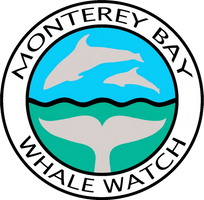WILD KILLER WHALES IN MONTEREY BAY

The best chance to see Killer Whales in Monterey Bay is in April and May. Although they aren’t here every day like the humpback whales, we often see the Killer Whales at that time of year as they come to Monterey Bay to hunt gray whales. In mid-April 2011, the humpback whales are just arriving, more each day and they will be feeding here through summer and fall.
Nancy Black, marine biologist for Monterey Bay Whale Watch, has been studying the killer whales for close to 25 years and her work with these whales and as they hunt gray whales has been featured on National Geographic, Animal Planet, Blue Planet Series, The Today Show and many other news sites. She prepared this feature story to provide information about wild Killer Whales, with special emphasis on the Killer Whales of Monterey Bay.
I would like to briefly describe the lives of wild Killer Whales in Monterey Bay, off central California. Killer Whales occur year-round in Monterey Bay, although on an unpredictable basis. We can encounter them on our whale watching trips any time of the year, although the peak time for sightings is April and May, when they frequent Monterey Bay to hunt Gray Whale calves.
In addition to Killer Whale sightings, our Monterey Bay Whale Watch trips focus on watching Humpback Whales, Blue Whales, Gray Whales, several dolphin and porpoise species, seals, sea lions, and sea otters. It’s not unusual for us to see groups of thousands of dolphins, as Monterey Bay is an extremely nutrient-rich and productive area for a tremendous diversity of marine life. Given this large diversity of marine mammals that feed or migrate through Monterey Bay, Killer Whales frequent this area to hunt other marine mammals as their natural prey, making Monterey Bay an ideal place for me to conduct my year-round and life-long study of these truly amazing, highly intelligent social mammals.
Types of Killer Whales
Three different eco-types of Killer Whales occur in Monterey Bay: 1) Transient Killer Whales (mammal hunting), 2) Resident Killer Whales (fish eating), and 3) Offshore Killer Whales (feeding on fish, sharks, and squid). Each population type is genetically distinct from the others, and they do not interact among types. They have distinct vocalizations, look physically different to the trained person, exhibit different social groupings and hunting tactics, and specialize on different prey. They may eventually each be considered separate species, as they do not intermix.
Resident Killer Whales Visiting Monterey Bay
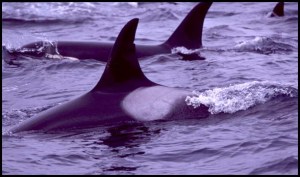
I was the first to discover that the “resident type” or fish hunting Killer Whales that are normally found in the Pacific Northwest (Southern Residents – J, K, and L pods) traveled all the way to Monterey Bay. Since this first sighting in 2000, we have observed them at least once during the winter on several years since then. These whales are now considered endangered as their preferred food source, Chinook Salmon, has drastically declined and the Killer Whales appear to have expanded their range in search of these fish. All our sightings of these whales are immediately reported to Ken Balcomb at the Center for Whale Research in Friday Harbor, Washington as Ken has been studying this group for over 30 years. See our earlier feature articles about Resident Killer Whales in Monterey Bay in 2000 and again in 2003.
Offshore Killer Whales
Less is known about the Offshore Killer Whales as they are unpredictable in occurrence and we generally observe them during the winter, in large groups of 50 -100 whales. We found that these whales have the longest range movements discovered so far for any Killer Whale population and we have recently co-authored a scientific paper on them. Individual whales identified in Monterey Bay have traveled to southern California and as far north as the Bering Sea in Alaska.
Transient Killer Whales
The “transients” or mammal hunting Killer Whales are the type most frequently sighted in Monterey Bay and we have over 130 individual whales in our catalog. The whales seen in Monterey Bay range from southern California to Washington, with a few sighted as far as British Columbia and Alaska. Certain groups are seen more often than others with a home range centered more around Monterey Bay. These whales are famous for hunting Gray Whale calves in Monterey Bay during the spring and our work with these whales has been featured on many nature programs on Television. For one example, see our feature about the National Geographic Explorer TV Program on Killer Whales of Monterey Bay.
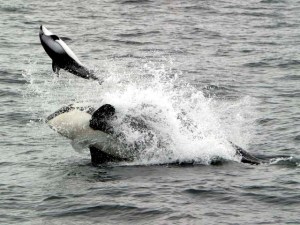
Killer whale, Orcinus orca, lethally hits a Pacific white-sided dolphin, Lagenorynchus obliquidens, off Monterey, California (Pacific)
We have observed these whales hunting other mammals as well, such as Harbor Seals, Elephant Seals, California Sea Lions, Dall’s Porpoise, Harbor Porpoise, Minke Whale, Pacific White-sided Dolphins, Long-beaked Common Dolphins, Risso’s Dolphins, and Bottlenose Dolphins.
Monterey Bay is the only place in the world where Killer Whales can be observed in an easily accessible area hunting and feeding on Gray Whales. This is a natural event and although Killer Whales are found throughout the world and are the most widely distributed whale, occurring from both poles to the tropics, and they do hunt large baleen whales in other areas, Monterey Bay is the only place to predictably observe this truly amazing event in nature, a battle among whale species, rivaling any other incredible predation events in nature, such as lions hunting buffalo or elephants, cheetahs chasing down antelopes at high speed, or wolves hunting bison and moose.
Killer Whale Culture
Killer Whales are true predators and are highly intelligent, social mammals living in a matriarchal society (with groups based on adult females and their offspring), exhibit complex communication patterns (similar to a language), and exhibit culture – with hunting strategies and knowledge of where to find prey, time of year to find specific prey and how to hunt different prey species successfully passed on among generations by females to their young. Even the males will generally stay with their mothers through life and mate with different family groups that are not closely related to them but still part of their population type. Females can live up to 80-90 years and males 50-60 years, with males reaching lengths of 30′ and 6 tons and females up to 26′ and 4 tons.
Killer Whales Hunting Dolphins in Monterey Bay
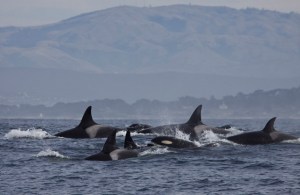
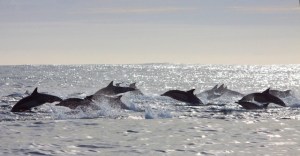
As a recent example of the natural life of these incredible animals, I am including photos of a recent event, as it is impossible to describe here all the amazing predation events we have observed over the years. On January 10th of this year (2010) on our whale watching trip we encountered a group of over 800 long-beaked common dolphins as they were fleeing from a group of eight Killer Whales. The dolphins were flying out of the water at high speed away from the Killer Whales. We passed the dolphins and caught up with the Killer Whales just after they caught a dolphin. When hunting dolphins, Killer Whales often track a distance of a quarter mile or more behind the school without alerting the dolphins to their presence. The Killer Whales are usually spread out over several hundred yards and wait for an opportunity to catch a dolphin by surprise. The whales will try to isolate a dolphin and come from below and often will toss the dolphin in the air by their head or flukes, while the other Killer Whales will all gather and several whales will work together to eventually kill the dolphin.
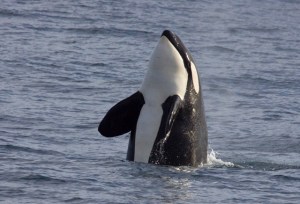
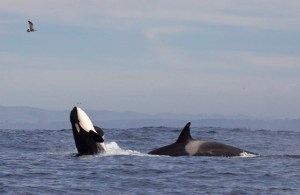 On our January trip, we arrived just after the Killer Whales caught the dolphin and had begun to feed on it. They spent just over 30 minutes feeding and sharing the prey among the group members before they started to continue on. After they fed on the dolphin, they became very social as they often do after such feeding events. The Killer Whales began to breach and spyhop, with lots of vocalizations (as they are very quiet vocally before a kill), exhibiting a very excited and high-energy state. It was incredible to observe their social behaviors as they continued this for nearly an hour, possibly a sort of “celebration” after the hunt. After this they continued traveling north and eventually slowed down and spread out again over half a mile. We followed them for several miles into the sunset before we headed back.
On our January trip, we arrived just after the Killer Whales caught the dolphin and had begun to feed on it. They spent just over 30 minutes feeding and sharing the prey among the group members before they started to continue on. After they fed on the dolphin, they became very social as they often do after such feeding events. The Killer Whales began to breach and spyhop, with lots of vocalizations (as they are very quiet vocally before a kill), exhibiting a very excited and high-energy state. It was incredible to observe their social behaviors as they continued this for nearly an hour, possibly a sort of “celebration” after the hunt. After this they continued traveling north and eventually slowed down and spread out again over half a mile. We followed them for several miles into the sunset before we headed back.

Killer Whales don’t stay in one area for long, otherwise their prey would move away; instead they range hundreds of miles along the coast and frequent Monterey Bay periodically. Passengers on the trip were completely awestruck to have witnessed such an amazing event and felt it was once in a lifetime opportunity for many.
Rewards of Viewing Whales and Dolphins in the Wild
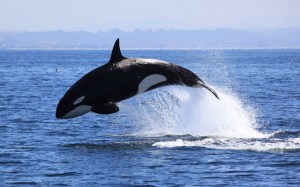
I expressed to everyone that seeing Killer Whales in the wild is so much more rewarding and enriching than watching them in captive “shows” where they are kept in an unnatural and small environment for such highly intelligent social animals. Times have changed and I think many people would prefer to see animals in their natural environment rather than in a captive situation where they are made to perform for crowds of people.
If you have more questions about wild Killer Whales, please send an email or call and I will try to answer your questions. The upcoming months of April and May (best mid April through mid May) are the next best time to view these animals in the wild. Although we don’t see the Killer Whales every day – generally several times a week or more – we see humpback whales daily and dolphins at this time as well. Many people come out with us more than once at this time of year to increase their chances of viewing Killer Whales and have an opportunity to see them hunt Gray Whales.
The humpback whales are also a highlight as they arrive in Monterey Bay to feed on small fish and squid from April through December and Gray Whales migrate through the area from December through May. Several dolphin species occur year-round and are frequently seen on our trips as well.
Chemical Contaminants and Killer Whales
During my research in collaboration with the National Marine Mammal Laboratory (NOAA) I collected small biopsy samples of several different Killer Whales and found that the whales have extremely high levels of chemical contaminants such as PCB’s, DDT’s, and flame retardants, all of which can be detrimental to these animals by affecting their reproductive rate and immune system. However, it’s hard to prove a direct link from these chemicals to physical effects on the whales.
The California transients I sampled in Monterey Bay have some of the highest known levels of these chemicals sampled so far for any Killer Whales. Unfortunately, California is a highly populated area and previous dumping and runoff of these chemicals into the oceans has taken place. Although some of these chemicals are banned, flame-retardants are still in use and all of these toxic chemicals do not degrade in the ocean and can linger in the marine environment over many years.
Since Killer Whales are top predators, they bioaccumulate these chemicals from the food chain as it’s passed up to higher level prey. The males can never get rid of the chemicals they accumulate but the females pass these chemicals along to their offspring and their first-born whales have the highest levels.
This is something we hope to continue monitoring in the future as well as looking at the survival of calves. In general, calf mortality could be as high as 40% and this could be related to the chemicals. Although the transients are not currently endangered, the chemical contaminants that are already in the ocean could pose a risk to their population and flame-retardants are still in use, though they are slated to be banned in the near future.
About Nancy Black and Monterey Bay Whale Watch
Besides leading whale watching trips as captain and marine biologist/naturalist guide, Nancy Black has also been conducting research on these whales for over 20 years and often uses her small research inflatable for this purpose. She has co-authored several research papers on these whales (see list below), published and was lead author on the first photo-identification catalog of Killer Whales for California and Mexico (as each whale can be identified by distinct markings on the dorsal fin and saddle patch), provided updated research poster presentations during each Biennial Conference for the Society of Marine Mammalogy (see PDF of this poster), often gives public presentations on Killer Whales (for such organizations as the Monterey Bay National Marine Sanctuary, Monterey Bay Aquarium, American Cetacean Society, Long Beach Aquarium, Long Marine Laboratory/UC Santa Cruz, Point Lobos State Reserve Docents, and others); and her research has been featured on many nature shows (Blue Planet – Discovery Channel; Secret Killer Whales of Monterey Bay – National Geographic; Whale Attack – Animal Planet; Killer Whales/Gray Whales TV Series with Jean Michael Cousteau of Ocean Futures on PBS, and others).
Nancy Black started Monterey Bay Whale Watch because she has a true passion for these animals and wanted to observe and learn more about them year-round in the wild. The Monterey Bay Whale Watch group stands alone as true experts on these animals, therefore providing the highest quality whale watching trips in the area and U.S., carefully respecting these animals by following all whale watch guidelines.
Research Papers Co-authored by Nancy Black
Harbor Porpoise Mortality in the Monterey Bay Halibut Gillnet Fishery, 1989 (1994)
Low worldwide genetic diversity in the killer whale (Orcinus orca): implications for demographic history (June 2002)
From wind to whales: trophic links in a coastal upwelling system (March 2005)
Use of chemical tracers in assessing the diet and foraging regions of eastern North Pacific killer whales (July 2006)
Evolution of Population Structure in a Highly Social Top Predator, the Killer Whale (March 2007)
